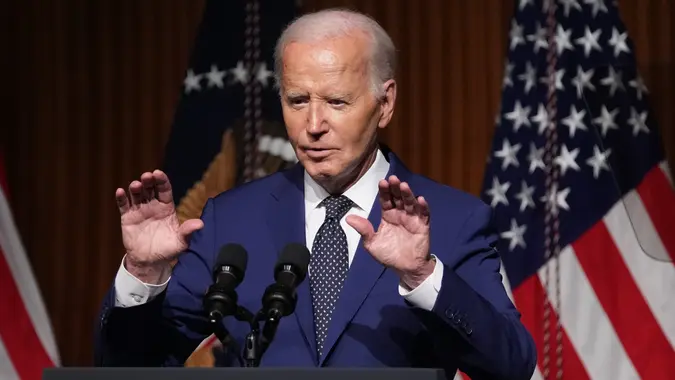3 Ways Biden’s Tariffs Affected the US Economy (And Your Money)

Commitment to Our Readers
GOBankingRates' editorial team is committed to bringing you unbiased reviews and information. We use data-driven methodologies to evaluate financial products and services - our reviews and ratings are not influenced by advertisers. You can read more about our editorial guidelines and our products and services review methodology.

20 Years
Helping You Live Richer

Reviewed
by Experts

Trusted by
Millions of Readers
President Donald Trump’s trade policy is almost singularly synonymous with tariffs, which he has levied or threatened to levy on everyone from fierce but far-away rivals like China to staunch neighboring allies like Canada.
However, former President Joe Biden also maintained or raised tariffs during his term in office. Here’s how they impacted both the economy and your wallet.
They Kept Cheap Chinese E-Cars Off of America’s Roads
According to the International Energy Agency (IEA), China has accounted for more than half the world’s electric vehicles since 2022 and more than 60% of the world’s e-car registrations. Although cheap, well-built Chinese EVs are popular in Europe and beyond, most Americans who haven’t traveled abroad have probably never seen one.
In 2024, Biden tripled a 25% Trump-era tax on imported Chinese e-cars to 100%, which “virtually guarantees” China will remain locked out of the U.S. market, according to the Carnegie Endowment for International Peace.
The Biden administration said the increase was designed to protect domestic auto manufacturing. However, it also denied American drivers access to electric vehicles that, according to the Associated Press (AP), rival the quality of U.S.-made EVs that cost three times more. Several popular and reliable Chinese EVs would cost $12,000 or less without tariffs.
They Made Russian Goods More Expensive
In 2022, President Biden announced 35% tariffs on a slew of Russian goods in response to the country’s invasion of Ukraine. According to Reuters, Biden suspended Russia’s “most favored nation” trade status and raised the tax on certain imports, including diamonds, seafood, alcoholic beverages, petroleum and other energy products.
In 2023, on the first anniversary of the invasion, the White House announced new tariffs on aluminum and more than 100 other Russian metals, minerals and chemical products worth nearly $3 billion.
While the move coincided with 2022’s record-high gas prices, the Atlantic Council argues that Biden’s tariffs didn’t cause them, as domestic oil production was more than sufficient to negate the loss of Russian imports.
They Raised the Cost of Some Imported Green Energy Components
In December 2024, the AP reported that outgoing President Biden was spending his waning days in office launching new tariffs and expanding existing ones on clean energy-related Chinese imports, including polysilicon, solar wafers and certain tungsten products starting Jan. 1.
While it’s too soon to measure the impact the import taxes have had on U.S. clean energy consumers, the Columbia University Center on Global Energy Policy writes that — like all tariffs — they are sure to cut both ways. While they might protect domestic producers by preventing cheap foreign goods from flooding the market, as Biden hoped his tariffs would, they can also increase costs for American companies by making globally sourced production materials more expensive.
 Written by
Written by  Edited by
Edited by 

























